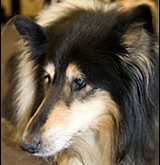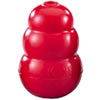

Distemper
Canine distemper is an infectious, airborne viral disease characterized by respiratory infection, fever, diarrhea, and in severe cases by convulsions or muscular twitching. The symptoms appear usually 6 to 12 days, sometimes as soon as 4 days, after exposure to the virus. Infected dogs should be well isolated, and professional veterinary treatment is imperative. Effective vaccines are available to protect the dog from this disease.
Infectious Canine Hepatitis
This is a viral disease with a great affinity for the liver and the lining of the blood vessels. It is spread by contact with discharges or urine from an infected dog. The disease may have a peracute ( very acute and violent) form, in which case the puppy may be listless and feverish for a day, then suddenly die. In the less acute form the incubation period is usually 6 to 9 days after exposure. Symptoms include abdominal pain, a fiery redness of the mucous membranes of the eye and mouth, listlessness, and fever.
Treatment consists of broad-spectrum antibiotics, blood transfusions, and general supportive therapy according to the needs of the animal. Modern preventive vaccines are frequently used in combination with distemper vaccine.
Leptospirosis
This is a bacterial disease of dogs and man generally produced by contact with urine from actively ill or convalescent animals. In acute cases the symptoms are vomiting, diarrhea, and rapid dehydration, leading to coma and death. Less acute cases show a visibly dejected dog, with a painful, drawn-up abdomen, high fever initially, with a rapid plunge to subnormal, vomiting of froth and bile, intense thirst, bloody dysentery, dehydration, and weakness.
Treatment consists of attempts to control the severe vomiting and dehydration and to aid kidney function. Short-term vaccines are helpful in reducing the risk of exposure.
Rabies
This is an acute viral infectious disease of warm blooded animals transmitted through the bite of an afflicted animal, though there is now evidence of airborne infection from masses of bats in "bat caves." The incubation period of the virus, which has a special affinity for nervous tissue, is usually from 12 to 30 days but it may be as long as 6 months or more.
Treatment of the afflicted dog, once the symptoms appear, is futile. The best barrier to the spread of rabies and the best safeguard for the dog is regular immunization. For people it high risk groups, such as veterinarians and hu mane society personnel, human vaccines are available.
Roundworms
These ascarid worms are about to 8 inches (12-20 cm) in length when fully grown, usually white or yellowish white in color and pointed at both ends. Infection is caused by swallowing the infective eggs of these worms which hatch in the intestines. The newly hatches larvae penetrate the intestinal wall and mi grate through the liver and lung tissues, finally returning to the intestinal tract. Unborn puppies can be infected by larvae migrating from the mother across the placenta. Since a dog can pick up the infective eggs on food or plaything dragged on the floor, the removal of all drop pings and strict sanitation are necessary to pre vent constant reinfection in puppies.
Roundworm infection in puppies is usually characterized by a potbelly, unthrifty appearance, capricious appetites, and intermittent vomiting and diarrhea. The worms may appear in the vomit or stool. Worming can be done at home, but since treatment is usually messy and proper dosages of the various drugs often difficult to gauge, professional veterinary care is strongly recommended.
Tapeworms
The tapeworm is made up of chain of body segments, or proglottids. The most posterior segments, which fill with eggs, break loose and are passed by the dog. These segments are commonly pinkish white in color, about 1/2 inch (12.5 mm ) in length, and flat and fleshy in appearance. They are capable of movement. Dead and dried segments, looking like brown grains of rice, may adhere to the dog's coat or be found in the dog's sleeping quarters.
The most common dog tapeworm, Dipylidium cavinum, requires partial development in the dog flea or dog louse before it becomes infective for the dog. The tapeworm eggs, passed by the dog, are ingested by fleas or lice that act as the intermediate host. Infected fleas or lice swallowed by the dog are digested, and the immature tapeworm is liberated.
Control of tapeworms is directed chiefly at eliminating the principal intermediate hosts fleas and lice. Treatment for tapeworms is best attempted in a veterinary hospital.
Heartworms
The adult heartworm, which may be 10 to 12 inches (25-30 cm) in length, commonly lives in the right ventricle of the heart. The female worms produce larvae (microfilariae) that circulate in the bloodstream. When mosquitoes ingest the microfilariae by feeding on an infected dog, the larvae develop to an infective stage. When the infected mosquitos bite another dog, the larvae are transmitted to it, thereby renewing the cycle.
Symptoms produced vary with the number of worms in the heart or pulmonary artery. A chronic cough, labored respiration, and collapse can result from heavy infestation. Milder cases show early fatigue upon any attempts at exercise. Treatment may consist of surgical removal of the adult worms from the heart, and the careful use of drugs to kill the microfilariae.
Hookworms
The most common dog hookwormis 3/8 to 3/4 inch (10-19 mm) in length and lives by attaching its mouthparts to the small intestine of the host. The females deposit many eggs, which pass in the feces and hatch outside to become infective larvae.
The infective larvae may either be ingested or penetrate through the skin. In puppies, prenatal infection can occur when the larvae mizrate through the tissues of the pregnant bitch. Larvae that are swallowed develop into adult worms within 2 to 3 weeks. Those larvae that penetrate the skin burrow into the blood capillaries and eventually get into the bronchi of the lungs and subsequently are coughed up and swallowed. They mature in the intestinal tract.
In puppies, large numbers of hookworms may cause profound anemia, leading to collapse. In less severe infections the puppies show a tarry and black diarrhea, anemia, and weakness.
Treatment of severely debilitated puppies consists of blood transfusions, administration of intestinal protectives and of liver and iron, and specific medication to kill the adult parasites. Strict sanitation is imperative.
Ticks. Ticks are external parasites that fasten themselves to their host and suck its blood. Isolated ticks on a dog can be removed with tweezers after stupefying the ticks with alcohol or acetone. For heavy infestations, periodic dipping of the dog is necessary. Owners of dogs with tick problems should obtain professional advice regarding sprays and dips many of the sprays can result in poisoning if used improperly r too frequently.
Fleas. Dog fleas deposit their eggs in litter on the ground. The newly hatched larvae, which are wormlike and bristly, pupate (begin the change to adult form) after 3 months. The bites of fleas are extremely irritating, and their saliva produces intolerable itching. Dogs harboring many fleas become sensitized and may develop a severe dermatitis. Much of the so-called summer eczema can be traced to a heavy flea infestation.
Bathing the dog in emulsions of pine oil, rotenone, or pyrethrum will kill the fleas it is carrying. The premises can be treated with 2.5% malathion in a spray, using precautions to avoid contamination of feeding utensils.
 Dogs and Glaucoma
Dogs and Glaucoma
Dogs and Glaucoma
Dogs and Glaucoma
 What Kind of Dog Should I Get?
Beagle
Credit: http://commons.wikimed
What Kind of Dog Should I Get?
Beagle
Credit: http://commons.wikimed
 How to have a Well Behaved Dog and Save Money at the Same Time
My partner was fixated on getting a pet dog, and cost w
How to have a Well Behaved Dog and Save Money at the Same Time
My partner was fixated on getting a pet dog, and cost w
 How To Train Your Puppy The Right Way
Train Your Dog Using Positiv
How To Train Your Puppy The Right Way
Train Your Dog Using Positiv
 Eight Great (and durable) Dog Toys
Eight Great (and durable) Dog Toys
There are thousands of
Eight Great (and durable) Dog Toys
Eight Great (and durable) Dog Toys
There are thousands of
Copyright © 2005-2016 Pet Information All Rights Reserved
Contact us: www162date@outlook.com